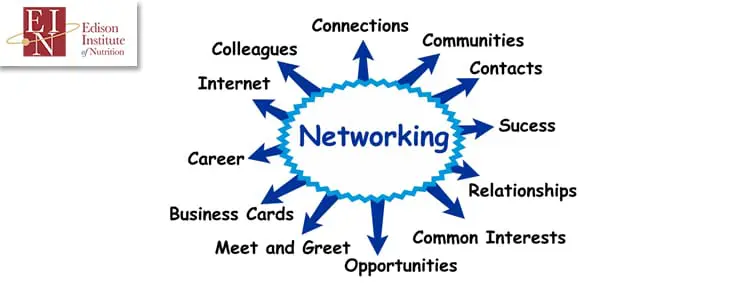
Are you are looking to build a successful referral network and career as a holistic nutritionist?
Perhaps you have been training as a registered holistic nutritionist by studying at a top rated online nutrition school.
Or maybe you are continuing your learning while building your own practice, for example through holistic nutrition wellness consultant courses at the Edison Institute of Nutrition.
When it comes to growing your business, building a referral network will reap great rewards.
Let’s look at some tips on building a referral network as a holistic nutritionist.
What Is A Referral Network?
For the majority of health practices, a significant number of clients come through referrals from other health care providers.
But it isn’t just medical doctors who refer their patients to specialists.
In the wellness industry, you can also connect with practices that complement your own, to share clients.
Once you have built a network of practices, they can become a steady source of new client referrals.
So how do you go about building this network, growing your network, and ensuring that clients are continually referred your way?
How To Build A Holistic Nutritionist Client Referral Network
Building a network requires a strategy and is a continual process rather than a one off event.
All your planning and execution will pay off over time when you find a continual source of new clients through the network that you have built.
So be patient.
Let’s start by taking a look at the steps required to plan your network.
1. Have A Clear Idea Of Your Target Client
To refine your search for referrals, begin by defining your target client.
Knowing your practice and the clients you serve will help you to determine where to search for referrals.
Use your current clients as a source of information: demographics, locale, and needs.
Are you serving primarily working professionals?
Do you specialize in any particular area of holistic nutrition?
Having a clear idea of the clients you already have will lead you to the type of clients you are looking for.
If, for example, you focus on how to manage arthritis with nutrition, you might consider connecting with naturopathic doctors, acupuncturists, or someone with a homeopathy degree who focus on the same.
2. Work On Your Pitch
To begin networking with other practitioners, you will need a strong pitch that positions your practice as the place they want to refer their patients.
Your pitch should convey relevant information about your business and can be printed out on flyers, or in an email.
Detail the way you will meet the needs and health goals of clients from the practitioners whom you are targeting.
Keep sentences short, concise, and positive, explaining your method and how you deal with your clients.
Be sure to include your contact information and the best way to refer clients your way.
Once you have established some contacts, go the extra step, and create a referral form for your practice to share with your network.
Make things as easy as possible for other healthcare providers to refer their patients to you.
Clear communication is one of the most important healthcare soft skills you’ll need to be effective as a professional holistic nutritionist, and your pitch is a big part of this.
3. Meet Other Health Professionals
Once you have your pitch, build a list of the health professionals in your area by making a spreadsheet with contact information and the best way to reach them.
Don’t just look at primary care physicians.
As a holistic nutritionist, your clients could be sourced from any number of health practitioners, including:
- Physiotherapists
- Women’s health professionals
- Gastroenterologists
- Psychotherapists and psychologists
- Eating disorder clinics
- Naturopathic doctors
- Registered massage therapists
- And many more
Reach out to each practitioner to set up a short ten minute meeting or phone call.
Learn a bit about each practice, their philosophy, and their clients and the hurdles they face.
Develop questions about their practice, focus on what you can do to benefit their clients, and then give them you pitch.
Ensure that you meet with the practitioner rather than the front desk staff.
Barring that, in a busy office, ask for the office manager to get approval to display marketing material at the practice you’re visiting.
After each meeting, be sure to update your notes with your findings.
Putting in the time to make a connection, keeping a record of each meeting and each referral will strengthen your network.
4. Set Up Your Practice Near To Complementary Practitioners
If you’re starting your own clinic, one thing to keep in mind is location.
Positioning yourself within a community of practices that complement your own is a great way to find new clients.
Make your practice easy to find and convenient for clients who are already visiting the area you situate yourself in.

5. Talk To Your Clients About Their Healthcare Team
An often untapped source of client referrals is your current clients.
Go one step further than asking them to refer their friends (which they should also be encouraged to do) by asking them about their other healthcare practitioners.
Perhaps there are local clinics that your search has overlooked.
If your client mentions an appointment with another practitioner, ask for that clinic’s contact info and follow up.
Sharing a mutual client is a great way to add a practice to your network.
6. Reach Out To New Practitioners In Your Area
If you have an established practice in an area where there are new businesses opening, check in with these businesses to welcome them to the area.
This will let them know that you’re nearby and open to referrals if they have clients who could benefit from your services.
A new clinic will often come with its own clients, but you can also offer them a helping hand by referring clients their way.
Continue to nurture your network and you will see your business grow.
7. Organize (Or Attend) A Local Wellness Professionals Meetup
Get yourself out into the community and connect with local wellness groups in order to let them know you’re accepting clients.
If there are no group meetups in your area, why not create one yourself?
Hand out business cards at this event and invite others to do the same.
Connecting with complementary businesses in this way will encourage an open, sharing community that supports one another.
8. Thank Your Referral Sources
Once you receive a referral, don’t forget to thank the practice who has sent the client your way.
Keep the referrer informed after seeing their patient by sending the results of their assessment to the referring clinic for their chart.
This both supports the client and highlights to the referring provider that you are supporting their patient.
9. Give Referrals To Get Referrals
Receiving referrals is a two way street.
Be alert to opportunities for referral of your own clients to those in your network of practitioners.
Referring clients to other practices will encourage them to refer their patients your way.
These are just some of the ways to build and nurture your referral network and help your business to grow.
Contact Edison Institute of Nutrition
If you have been looking to establish a practice as a holistic nutritionist, the first step is to get accredited to practice.
We offer new practitioner accreditation and an accelerated program for professionals.
So, whether you are just starting out or you are looking to keep your practice up to date, contact Edison Institute of Nutrition today.
